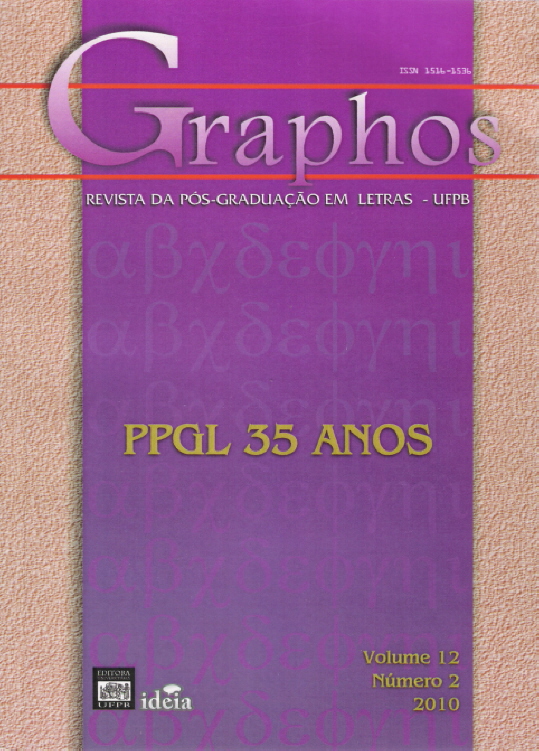ABC, folheto, romance ou verso: a literatura impressa que se quer oral
Keywords:
Culture, Immaterial heritage, Oral culture, Popular literature, Cordel literatureAbstract
Brazilian northeast popular literature in verses, today known as Cordel literature, is
discussed in its relationships with orality. The concept of orality should be understood not only as a
way to transmit knowledge, but, mainly, as a system of knowledge typical from oral cultures, what
differs from the system of written cultures. The contribution for studies in this area states on data
obtained by research work, in which audiovisual recording done from the folhetos performed by
singing or presented out loud, with or without reading the texts in real time. In most cases, the
narrated poems are memorized, known by heart and only read when memory fails. Both iliterate and
those who read the poems and memorize them configure themselves as “book men” and “book
women”, for sorting out certain stories, identifying themselves with such stories to the point of
offering their own bodies as a cover for those titles. There are some people who are a kind of “living
libraries” of this kind of literature, representing really the Brazilian immaterial heritage. This is the
first result of a new research on a subject that has been gathering sparse experiences throughout
decades of observation, audio and audiovisual recordings.
Downloads
References
ARANTES, A. A. O trabalho e a fala. São Paulo: Kairós; FUNCAMP, 1982.
AYALA, Maria Ignez Novais. No arranco do grito. São Paulo: Ática, 1988.
CANDIDO, A. Literatura e sociedade. 2. ed. São Paulo: Duas Cidades, 1967.
_____. Os parceiros do Rio Bonito. 2. ed. São Paulo: Duas Cidades, 1971.
_____. Textos de intervenção. São Paulo: Duas Cidades; Ed. 34, 2002, p. 77-92.
CALASANS, José. Canudos na literatura de cordel. São Paulo: Ática, 1984.
CUNHA, Euclides. Caderneta de campo. São Paulo; Cultrix, 1975.
GRAMSCI, Antonio. Literatura e vida nacional. Trad. Carlos Nelson Coutinho. Rio de Janeiro: Civilização Brasileira, 1968.
HOGGART, Richard. As utilizações da cultura: aspectos da vida cultural das classes trabalhadoras (2.v.)
RINARÉ, Rouxinol de. Um curumim, um pajé e a lenda do Ceará. 2. ed. Ilustrações Rafael Limaverde. . Fortaleza: IMEPH, 2007.
VIANA, Arievaldo. A ambição de Macbeth e a maldade feminina (livre adaptação da obra Macbeth, de William Shakespeare). Ilustrações Jô Oliveira. São Paulo: Cortez, 2008.
_____. O pavão misterioso: recriação da obra de José Camelo Resende e João Melquíades Ferreira. Ilustrações Jô Oliveira. Fortaleza: IMEPH, 2007. (Literatura de Cordel Ilustrada
TERRA, Ruth B. L. “Literatura de folhetos: persistência de uma forma de comunicação popular”. Texto-base para comunicação apresentada no IX Encontro Brasileiro de Comunicação Social, item
IV por uma memória da documentação popular, Painel “Usos e abusos da literatura de cordel”. (mimeo.)
_____. Memória de lutas: literatura de folhetos do Nordeste (1893—1930). São Paulo: Gobal, 1983.
THOMPSON, E. P. Costumes em comum: estudos sobre a cultura popular tradicional. São Paulo: Companhia das Letras, 1998.
XIDIEH, Oswaldo Elias. Narrativas populares: estórias de Nosso Senhor Jesus Cristo e mais São Pedro andando pelo mundo. Belo Horizonte: Itatiaia; São Paulo: EDUSP, 1993. (Reconquista do Brasil, 173).
DVDs
AYALA, Ignez. Azulão: a voz do folheto. (2007)
CABRAL, Elisa Maria. Olhos da alma, cantos do coração. (1999)
CALDAS, Laurita. J. Borges. (2003)







